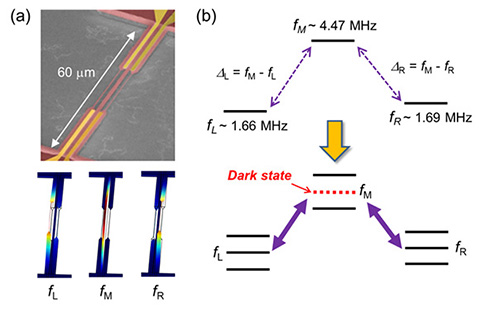A Strongly Coupled Λ-type Micromechanical System
The ability to control phonon transport in semiconductor micromechanical systems has important consequences for applications, such as ultralow-power-consumption mechanical memories and logic gates [1,2]. Such phonon manipulation requires strong coupling of adjacent mechanical resonators, that is, energy exchange between the resonators at a rate larger than the energy dissipation. Parametrically coupling mechanical resonators via the periodic modulation of stress is an effective way to realize strong coupling. This has been recently demonstrated in GaAs mechanical systems using the piezoelectric or photothermal effect [1,3], where the modulation with the frequency difference between the mechanical resonators (modes) allows strong on-chip coupling as well as its on-off switching. However, such a demonstration has been limited to two-resonator systems and not yet expanded to multiple-resonator (array) ones. Here, we demonstrate strong coupling among three SiN mechanical resonators via dielectric stress modulation with an electric field [4].
The sample consists of three SiN doubly clamped beams, where the middle beam (beam M)
is sandwiched by two metalized beams (beams L and R) [Fig. 1(a)]. Because the mode frequency of beam M (fM) is higher than that of beams L (fL) and R (fR), it forms a Λ-type three-level system as shown in Fig. 1(b). All the levels are frequency-shifted in an electric field applied between beams L and R, that is, the three resonators are coupled via the dielectrically induced attractive force. However, strong coupling is not achieved only with this DC field because of the frequency mismatch between beam M and beam L (R). To compensate for this frequency mismatch, the electric field is AC-modulated with the frequency difference between the two modes (ΔL(R) = fM – fL(R)). Then, beam M and beam L (R) are parametrically coupled, leading to the splitting of each level. When the two modulation tones (ΔL, ΔR) are simultaneously applied, each of the three levels splits into three. Here, one state of beam M is "dark", where the vibration amplitude is canceled out [Fig. 1(b)]. This is due to the destructive interference of the three beams and is evidence of the formation of a strongly coupled Λ-type mechanical system.
This work was supported by MEXT KAKENHI JP15H05869, JP15K21727 and collaborated with Swiss Federal Institute of Technology in Lausanne (EPFL).
- [1] H. Okamoto et al., Nature Phys. 9, 480 (2013).
- [2] T. Faust et al., Nature Phys. 9, 485 (2013).
- [3] R. Ohta et al., Appl. Phys. Lett. 107, 091906 (2015).
- [4] H. Okamoto et al., Appl. Phys. Lett. 108, 153105 (2016).

|
| Fig. 1. (a) Scanning electron micrograph of the device: red, SiN (100 nm thickness); yellow, Au (45 nm thickness); grey, Si substrate. Simulated mode shape of the three mechanical resonators is also shown. (b) Energy level diagram of the Λ-type micromechanical system. Each of the three levels splits into three when the two frequency modulation tones (ΔL, ΔR) are simultaneously applied. Notably, one state of beam M is “dark” in the sense that it involves no motion of the middle beam |